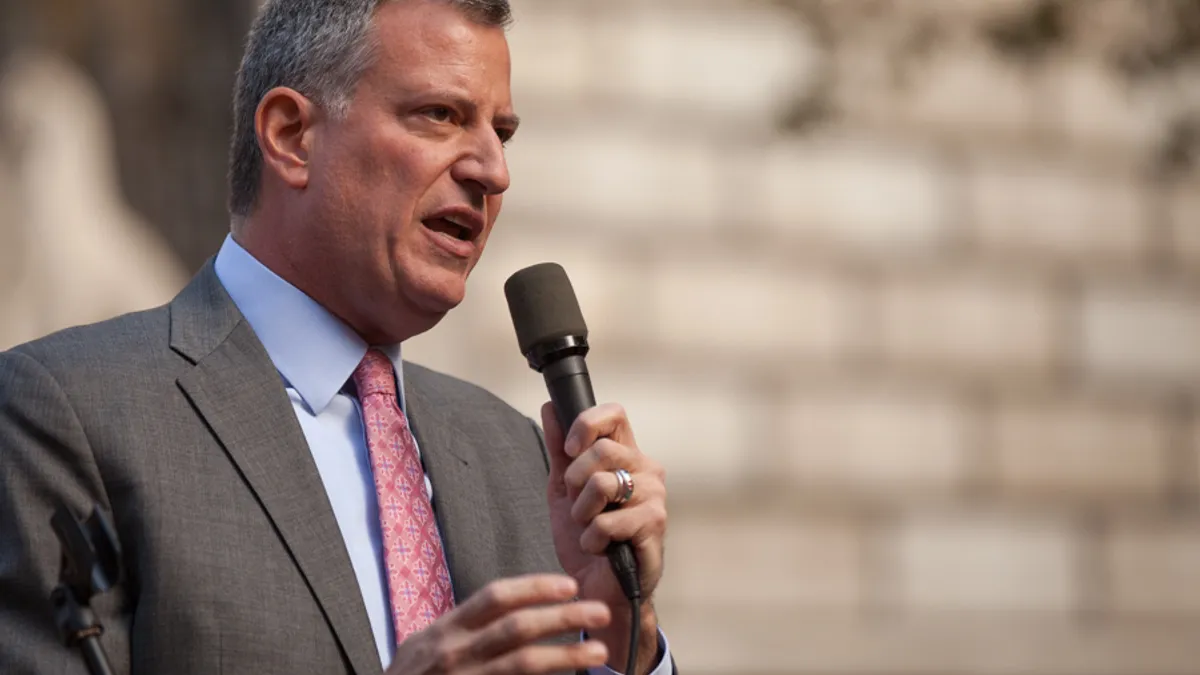Dive Brief:
- Two years after setting a goal of "zero waste" by 2030, New York is reporting incremental progress and a new effort to "rethink garbage in groundbreaking ways that treat it as a resource for creating products, energy, and a greener city." According to its annual OneNYC update, the city achieved a 10.9% reduction (from a 2005 baseline) in residential refuse generation last year with a 16.9% diversion rate. The goal is to reach 90% reduction by 2030.
- Switching to single-stream recycling by 2020 is seen as one way to reach that goal. The city reports that while progress is slightly behind schedule, a consultant's study is slated for completion this summer and they aim to begin capital improvements at the Sims Municipal Recycling facility by the end of the year.
- Diverting organic waste collected from both commercial and residential sources is another key priority, though progress has been slower than expected on local processing infrastructure. Some vendors that were selected for long-term processing contracts are still making the necessary facility upgrades and the city's co-digestion project at the Newtown Creek Wastewater Treatment Plant is not yet fully operational. The city aims to be handling at least 100 tons of material per day at the digester - eventually scaling up to 250 tons - and start construction on a gas-to-grid project by the end of the year.
Dive Insight:
The city has been busy in the two years since Mayor Bill de Blasio announced his "zero waste" goals at a 2015 Earth Day event in the South Bronx. Through a series of new and existing initiatives, the Department of Sanitation (DSNY) has indeed facilitated more diversion of recyclables, organics, electronics, textiles and other items. New York now has the largest curbside organics collection program in the country and aims to expand access to 3 million residents by the end of year. Recycling programs now exist in 122 public schools and access is available to all of the city's more than 400,000 public housing residents for the first time.
On the commercial side, diversion requirements covering large businesses that generate about half of the city's commercial organic waste are also now in full effect. Diversion requirements for all commercial recyclables have also been updated to match residential rules. In another sign of how much the commercial conversation has changed since 2015 the city is now fully backing plans for a franchise zone system. While DSNY has pledged to work with local haulers, the report's language makes it clear what they expect of the industry. "Our air will be cleaner, our streets will have less traffic, carters won’t inefficiently crisscross the City, and customers will receive more reliable service. Allowing the industry to adjust, these changes will be incorporated over several years," reads the report.
Yet even as all of this framework for the city's plan falls into place, it's too early to tell whether that plan is aggressive enough to get a grip on the more than 6 million tons of residential and commercial waste generated in New York every year. Switching to single-stream will likely increase capture rates, and expanding organics diversion access will help, though a lack of available space makes siting some of the necessary processing infrastructure to handle more material locally a challenge. In the meantime, population growth continues and the city plans to keep utilizing long-distance landfills for decades as part of an export plan that could soon peak at $420 million per year.
DSNY is still considering the option of a "save-as-you-throw" financial incentive system, which could be one of the most effective ways to drive reduction if it can overcome political hurdles, and remains open to lessons learned in other cities with similar goals. Though because of its scale and density New York remains unique among other "zero waste" cities. All of those cities, as well as many companies in the industry, will surely be watching with great interest as the nation's largest urban waste experiment continues.















